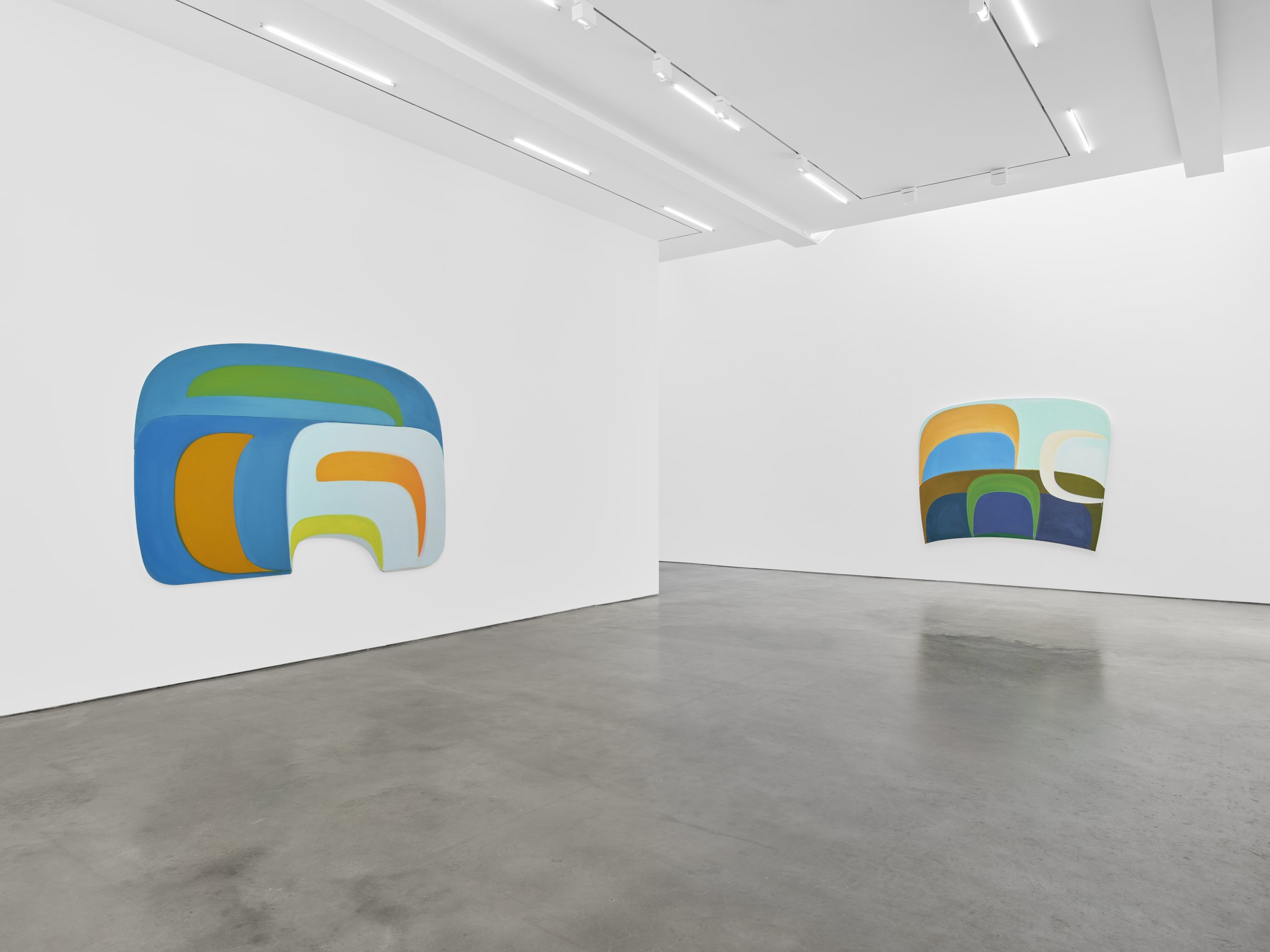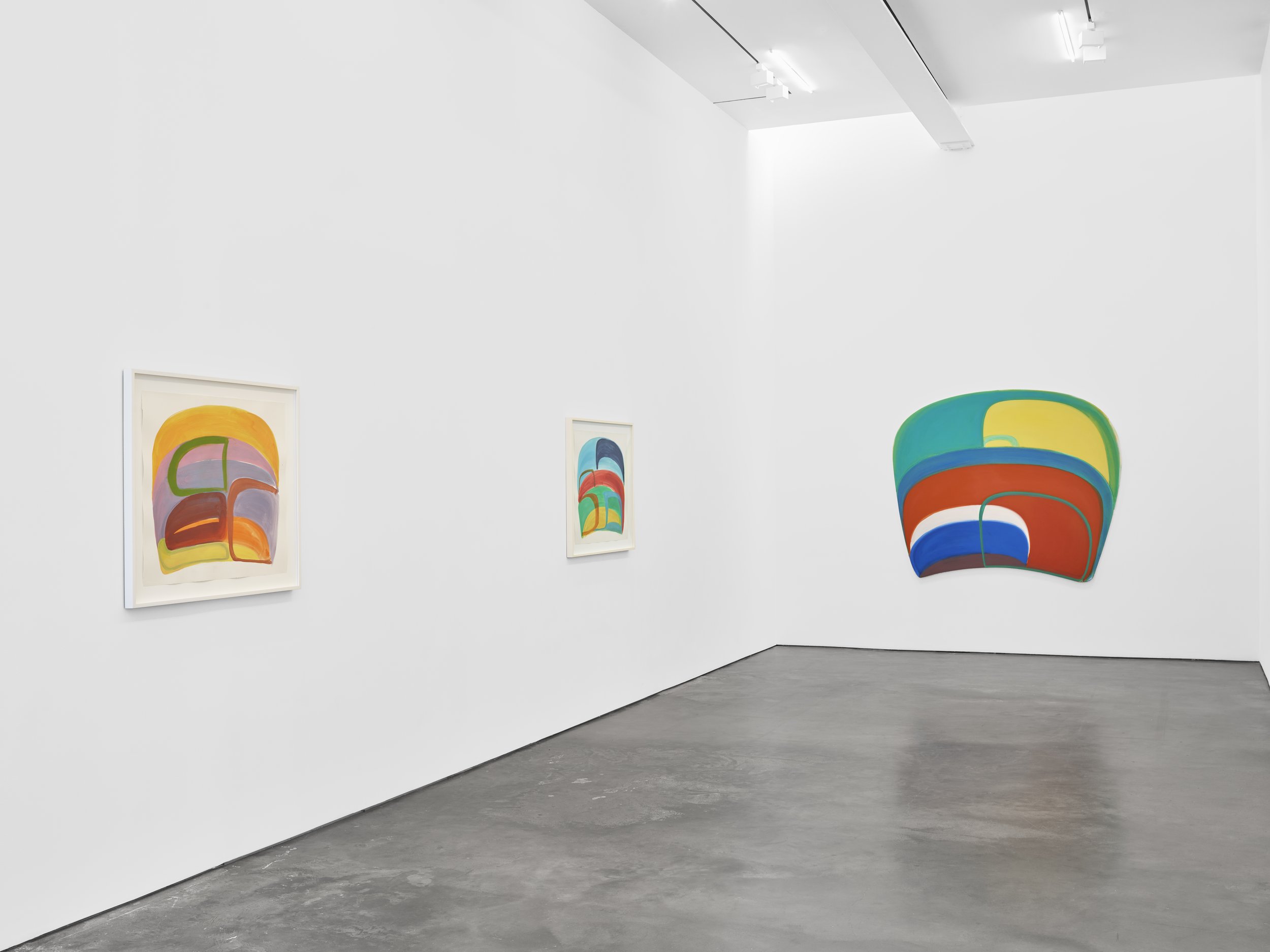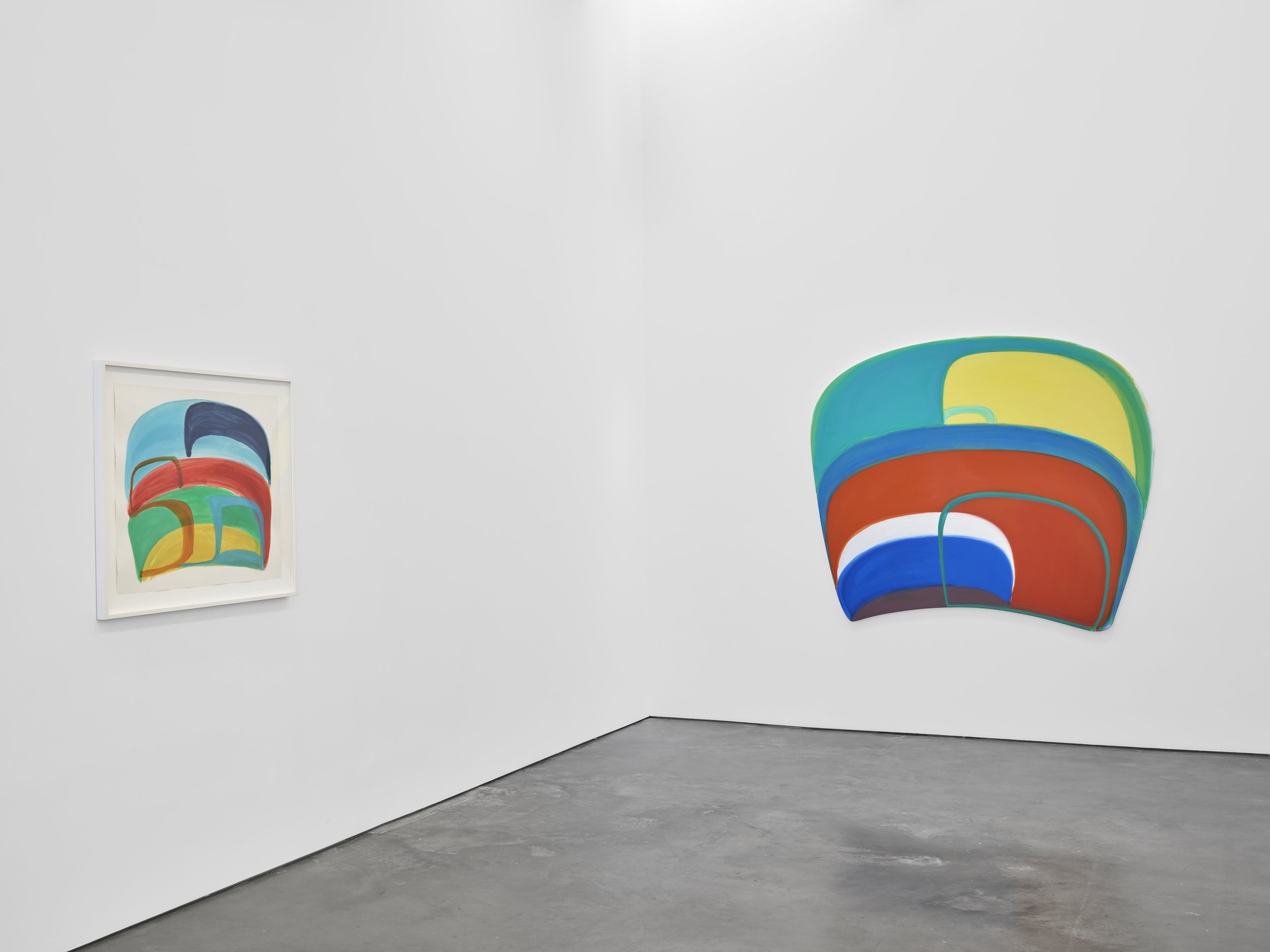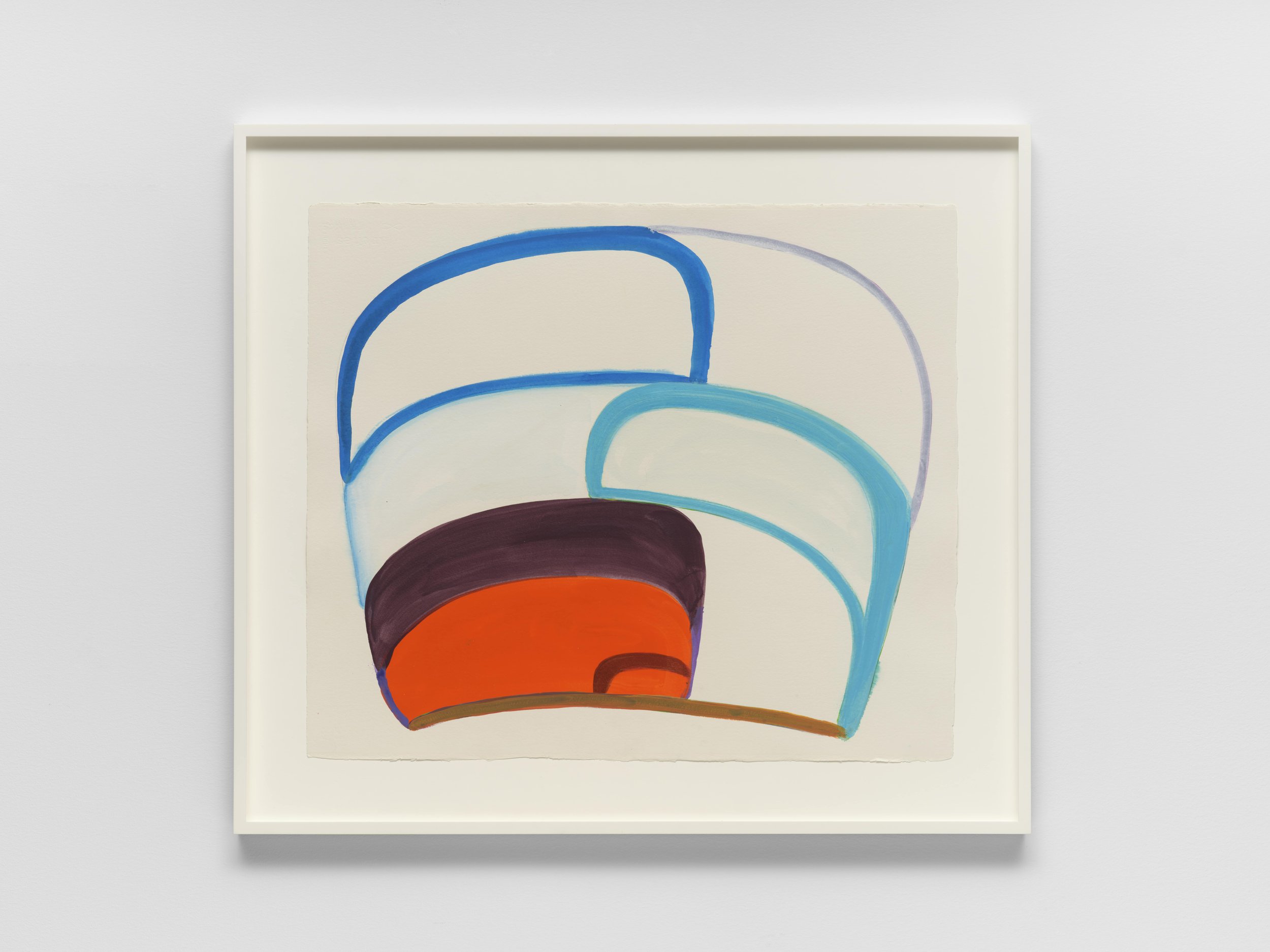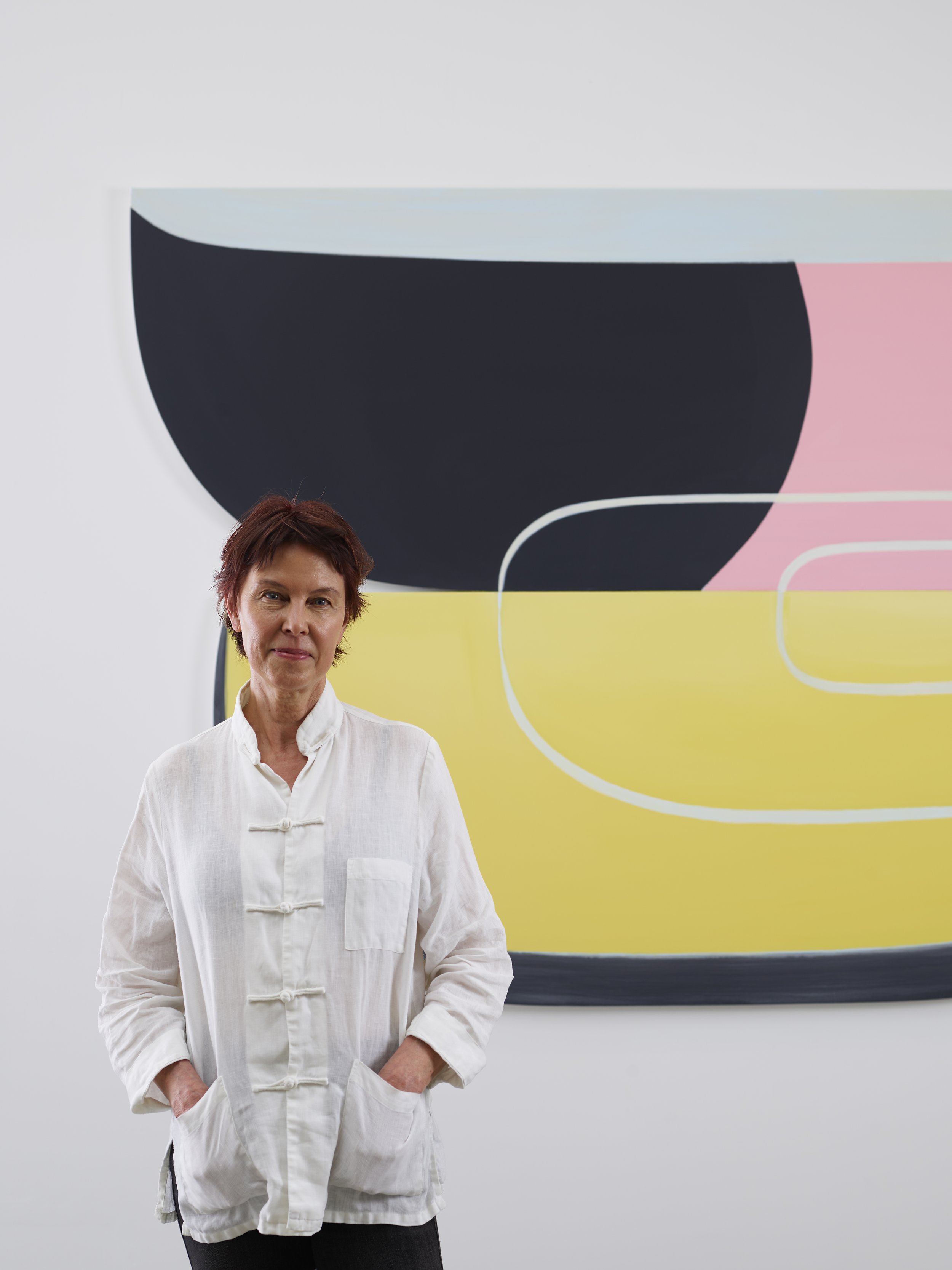Joanna Pousette-Dart: ‘Centering’
Exhibition view of Joanna Pousette-Dart’s ‘Centering’ at Lisson, Gallery New York, 5 September – 19 October 2024 © Joanna Pousette-Dart, Courtesy Lisson Gallery
“I had to make a break, which had a lot to do with the physical way color and light and materiality come together and are contained in a painting. I liked the idea that the shape of a painting could be defined by my peripheral vision, or my mind’s eye and what it chooses to take in and how it edits and frames the world.”
For her seventh exhibition with Lisson Gallery, Joanna Pousette-Dart returns to her native city with a major show of new paintings, entitled ‘Centering’. Since the 1970s, when the artist began moving away from traditional rectilinear formats – initially by intertwining unstretched canvas into soft grids and then by creating shaped canvases on which to paint in the 1990s – Pousette-Dart has been utilizing dynamically shaped formats to suggest the expansive, visceral, and all-encompassing qualities of landscape. From these surfaces of vertically joined curvilinear panels, she has reimagined painting as an arena of depth and breadth, creating a light and space continuum where the inner drawing is in constant dialogue with the outer shape, and everything is in perpetual motion. To further enhance the living, breathing quality of these forms and the constantly shifting and expanding worlds within worlds, the artist bevels the edges of the paintings so that they appear to float off the walls.
Joanna Pousette-Dart Centering #1, 2024 Acrylic wash on Arches watercolor paper 56.5 x 67 cm 22 1/4 x 26 3/8 in © Joanna Pousette-Dart, Courtesy Lisson Gallery
Pousette-Dart’s new arching and domed works further this exploration, but have a uniquely encompassing quality. Each is hand drawn and subtly asymmetrical, giving the paintings a slight list or the suggestion of spin, which sets the fields of colors and forms in motion. Each is comprised of two panels with a ‘horizon’ line that divides the space differently from one painting to another, so that the interior space of each painting has its own rise and fall or gravitational pull. Horizontal bands of color suggest a hierarchy of distances and fluctuating qualities of light achieved through the accumulation of thinly applied layers of varying, sometimes complimentary tones. The color modulates sometimes subtly and at other times dramatically from light to dark, or warm to cold and becomes one of the ways in which Pousette-Dart moves us though the cyclical and rotational motions inherent in each work, visually suggesting a passage from one state or realm to another. Her singular vocabulary of lines and calligraphic forms defines the orientation, as well as the sense of drama and focus of each painting, at times functioning in opposition to its internal movement and at others, echoing it.
Joanna Pousette-Dart Centering #7, 2024 Acrylic wash on Arches watercolor paper 74.3 x 87.6 cm 29 1/4 x 34 1/2 in © Joanna Pousette-Dart, Courtesy Lisson Gallery
In addition to the New Mexican vistas she's been recalling and revisiting for many years, Pousette-Dart’s influences range widely from Mozarabic manuscripts and Catalan frescos to Etruscan tombs and Chinese landscape painting, to name but a few. Key to her painterly process is an intuitive approach to creating each image. She describes it as unearthing the painting’s visual and poetic logic and it involves examining a range of shifting possibilities by working through large revisions and incremental adjustments until the elements coalesce and the painting achieves its own sense of ‘presence’. For her it’s always a surprising and revelatory process and the residue of layers and gestures from various stages accrue and add richness to her images.
Joanna Pousette-Dart Centering #2, 2024 Acrylic wash on Arches watercolor paper 56.5 x 66.7 cm 22 1/4 x 26 1/4 in © Joanna Pousette-Dart, Courtesy Lisson Gallery
While suggesting a vast sense of space, her paintings are resolutely human in scale, having been shaped by her own field of vision and the physical reach of her hand. Equally important to their scale and composition is the artist’s inclusion of the viewer as integral to that experience. At the same time, these asymmetrical, vertiginous compositions suggest qualities of imminent change and realignment, so it is indeed the presence of the viewer that balances and centers the activity of each painting. And just as the artist enters into a negotiation with each work – wrestling with its internal dynamics – so too the viewer is placed front, center and in dialogue with each painting.
Portrait of Joanna Pousette-Dart, 2021. © Joanna Pousette-Dart, Courtesy Lisson Gallery
About the artist
Born in New York to abstract expressionist painter and founding member of the New York School of painting, Richard Pousette-Dart, and having studied painting at Bennington College in Vermont amongst the likes of Greenbergian Formalists Kenneth Noland and Larry Poons, Joanna Pousette-Dart’s experience as a painter rises from rich tradition. However, despite this traditional modernist background, her paintings remain anything but conventional. Pousette-Dart’s shaped paintings are unique in their melding of formal and poetic concerns, and take their inspiration from many sources: Islamic, Mozarabic and Catalonian art, Chinese landscape paintings and calligraphy, Mayan and American Indian art, as well as the landscape itself, to name a few. In the early 1970s, Pousette-Dart began living and working intermittently in New Mexico. Her perceptions of the place deeply influenced her paintings, ultimately resulting in the abandonment of a rectangular format in the 1990s for works composed of curved panels. The dynamic configurations of these works evoke the constantly shifting light and form, the vastness of the spaces, and the sense of the earth’s curvature that she experienced there. Her paintings take many forms, each with its own dynamic sense of expansion and compression, buoyancy and gravity. The painted contours of the interior shapes create an added complexity, sometimes echoing the contours of the canvas, and at other times challenging them. Her use of color suffuses all elements with a sense of light which feels redolent of the natural world.
Joanna Pousette-Dart was born in New York, NY in 1947, where she still lives and works. She has a BA from Bennington College, Vermont (1968). Her work has been the subject of solo exhibitions at Wiesbaden Museum, Wiesbaden, Germany; Locks Gallery, Philadelphia, PA, USA; Moti Hasson Gallery, New York, NY, USA; Texas Gallery, Houston, TX, USA; Charles Cowles Gallery, New York, NY, USA; and Susan Caldwell Gallery, New York, NY, USA, as well as a three-person exhibition at MoMA PS1 in New York. Pousette-Dart has been featured in group exhibitions at the University of Connecticut, Storrs, CT, USA; School of Visual Arts, New York, NY, USA; Museum of Fine Arts, Boston, MA, USA; Museum of Modern Art, New York, NY, USA; Indianapolis Museum of Art, Indianapolis, IN, USA; Neuberger Museum, Purchase, NY, USA; Whitney Museum of American Art, New York, NY, USA; and the Santa Barbara Museum of Art, Santa Barbara, CA, USA, among others. Her work is held in public collections around the world including Albright Knox, Buffalo, NY, USA; Museum of Fine Arts, Boston, MA, USA; Brooklyn Museum of Art, Brooklyn, NY, USA; Solomon R. Guggenheim Museum, New York, NY, USA; Museum of Modern Art, New York, NY, USA; Indianapolis Museum of Art, Indianapolis, IN, USA; Parrish Art Museum, Southampton, NY, USA; Portland Art Museum, Portland, OR, USA; Solomon R. Guggenheim Museum, New York, NY, USA. In 2021 she was selected to become a National Academician by The National Academy of Design in New York.
About Lisson Gallery
Lisson Gallery is one of the most influential and longest-running international contemporary art galleries in the world. Today the gallery supports and promotes the work of more than 70 international artists across spaces in London, New York, Los Angeles, Shanghai and Beijing. Established in 1967 by Nicholas Logsdail, Lisson Gallery pioneered the early careers of important Minimal and Conceptual artists such as Art & Language, Carl Andre, Daniel Buren, Donald Judd, John Latham, Sol LeWitt, Richard Long and Robert Ryman among many others. It still works with many of these artists and others of that generation, from Carmen Herrera and Olga de Amaral to Hélio Oiticica and Lee Ufan. In its second decade the gallery introduced significant British sculptors to the public for the first time, including Tony Cragg, Richard Deacon, Anish Kapoor, Shirazeh Houshiary and Julian Opie. Since 2000, the gallery has gone on to represent many more leading international artists such as Marina Abramović, Ai Weiwei, John Akomfrah, Liu Xiaodong, Otobong Nkanga, Pedro Reyes, Sean Scully, Hiroshi Sugimoto and Wael Shawky. It is also responsible for raising the international profile of a younger generation of artists including Dana Awartani, Cory Arcangel, Garrett Bradley, Ryan Gander, Josh Kline, Hugh Hayden, Haroon Mirza, Laure Prouvost and Cheyney Thompson.
The exhibition opened on September 5 with an opening held from 6 – 8pm and will be on view until 9 October 2024 at Lisson Gallery New York location at 504 West 24th Street, New York.
For more information about this exhibition and others, please visit the Lisson Gallery here. The gallery can also be found on Facebook, YouTube, and Instagram.
